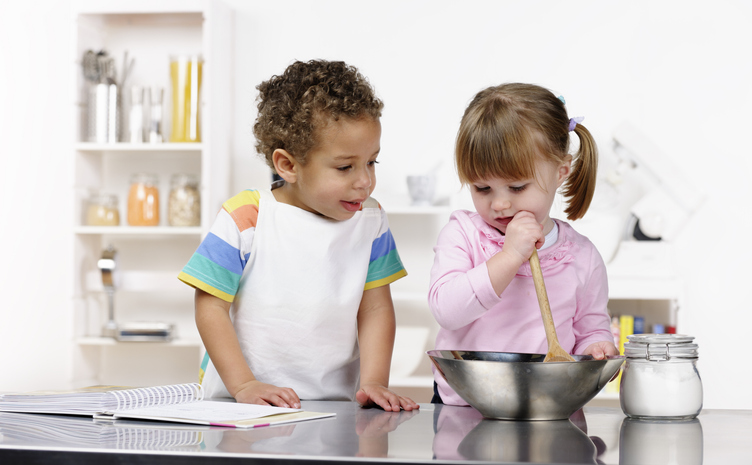Imagine having your teaching setting filled with delicious scents and seeing your children willingly dig into healthy foods. How can you make this happen? One of the best ways is to offer healthy cooking experiences. Whether you work in family care, a child care facility, or even a public school, there are many ways you can make cooking a part of your day.
Cooking with children offers benefits across many learning domains!
Math: Helps children use standard measurement in meaningful ways. Solving simple problems mathematically occurs naturally as children decide how much to prepare, how to portion the food, and so forth.
Science: Shows children how ingredients can be transformed by temperature changes and combined with other ingredients.
Health: Research suggests that children who participate in cooking are more likely to make healthy food choices. Children also learn the importance of healthy habits such as washing hands. They improve fine motor skills as they use tongs, whisks, and similar tools.
Language/Literacy: Vocabularies grow as children learn the names of ingredients, cooking terms, and more. Following a recipe is also a practical way to build early reading skills. Picture recipes help pre-readers learn that printed materials have meaning.
Social/Emotional: Cooking with others provides practice in cooperation, sharing, and taking turns. It boosts children’s self-confidence and teaches them that their efforts pay off with tasty results.
Social Studies: Exposes children to foods from a variety of cultures.
Creative Arts: Many cooking experiences allow children to arrange foods in artistic and creative ways.
So how can you safely include cooking in your setting?
This will depend on the age and maturity of the children you work with, as well as your facilities. Sandwiches, yogurt sundaes, and other delicious foods can be prepared without using heat. These recipes are ideal for younger children. Toaster ovens, slow cookers, microwave ovens, and similar small appliances can be used with older children even if you do not have access to a full kitchen. Here are some safety tips for all cooking activities:
Cleanliness: Wash hands thoroughly before the activity begins. Repeat after handling raw meat, eggs, or similar foods. Be sure all work surfaces and equipment are clean.
Eggs: Children should not taste batters or other foods that contain raw eggs. These can be a source of salmonella. Using pasteurized eggs or egg substitutes can help you avoid this issue.
Maintain Proper Temperature: Refrigerate perishable ingredients or keep them in a well-insulated ice chest.
Food Restrictions: Plan to prepare foods that are safe for everyone in the group. Check for allergies or other food restrictions. For younger children, avoid foods that can potentially cause choking, such as popcorn or grapes. Some children may require gluten-free foods, need to avoid lactose, or have nut allergies.
With all the benefits cooking experiences provide, you’ll want to include cooking as a regular part of your curriculum!
Back to blog listing